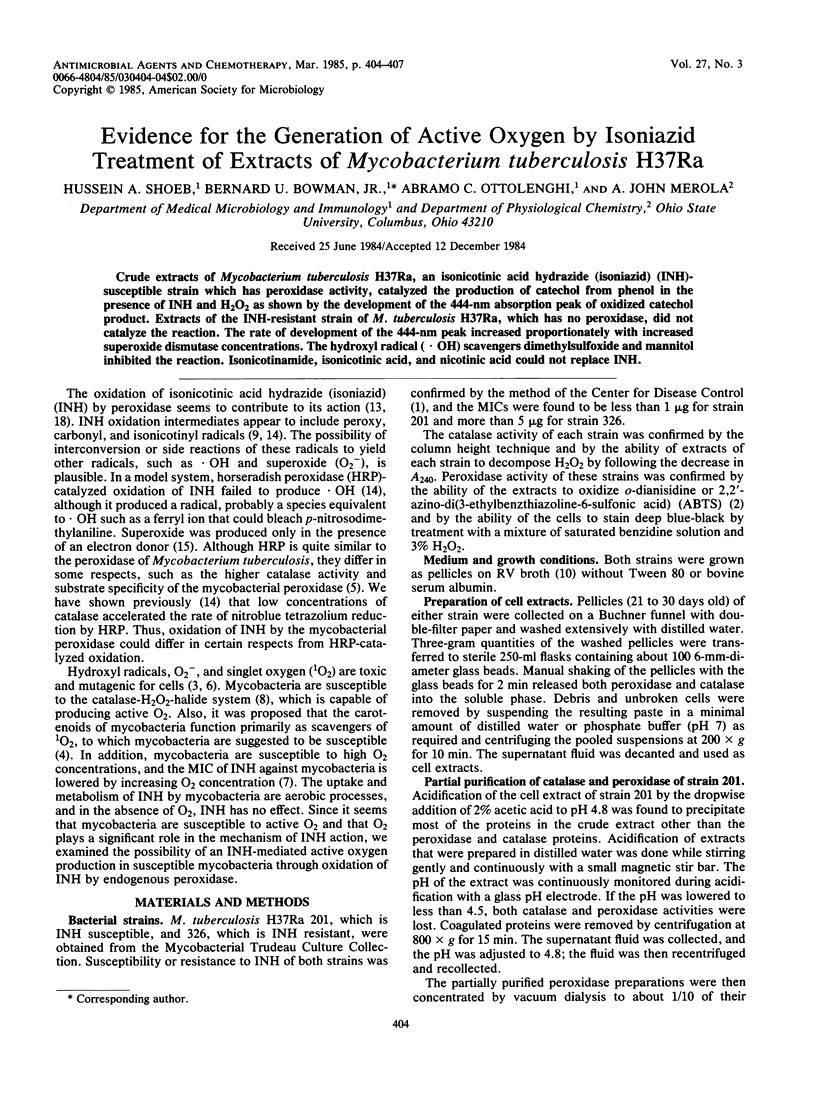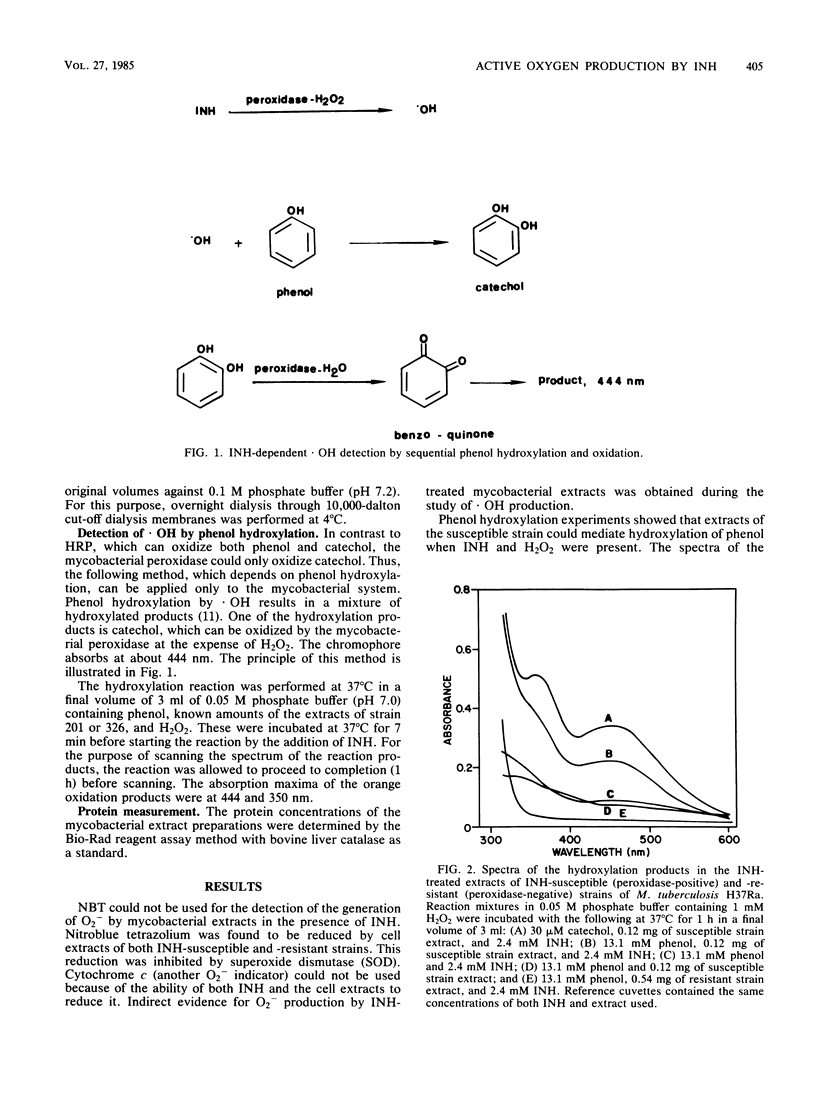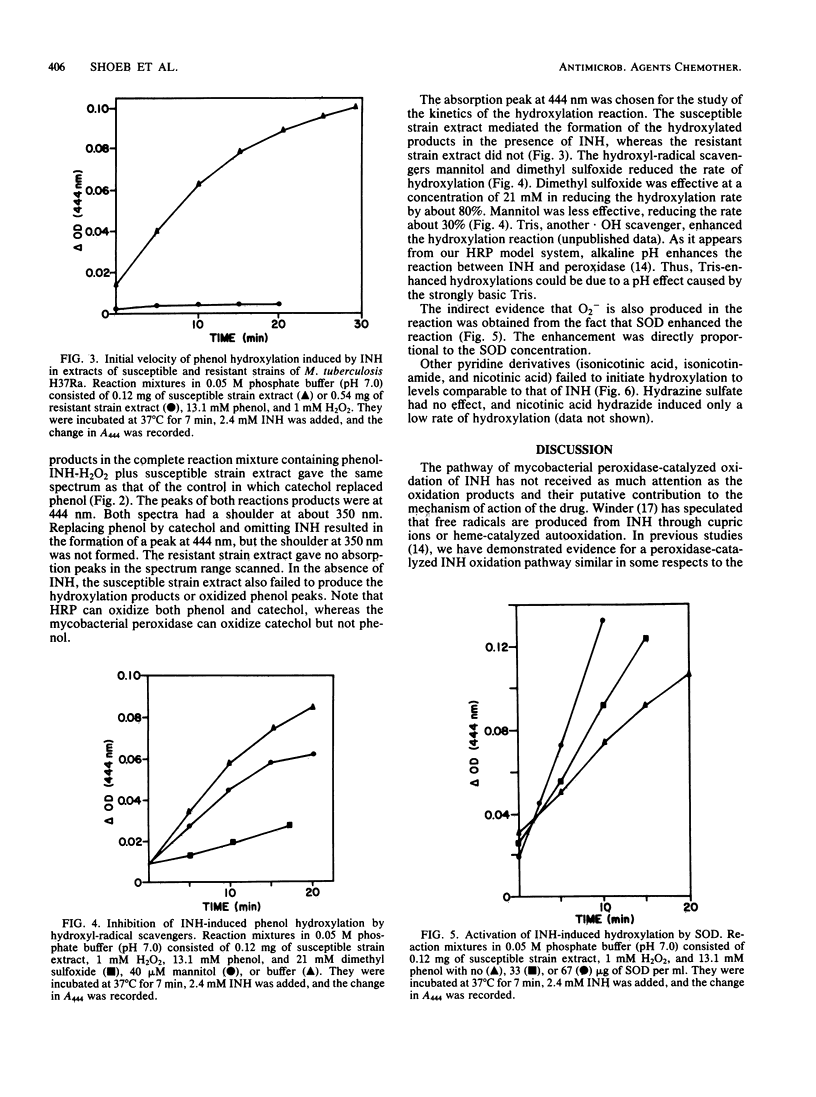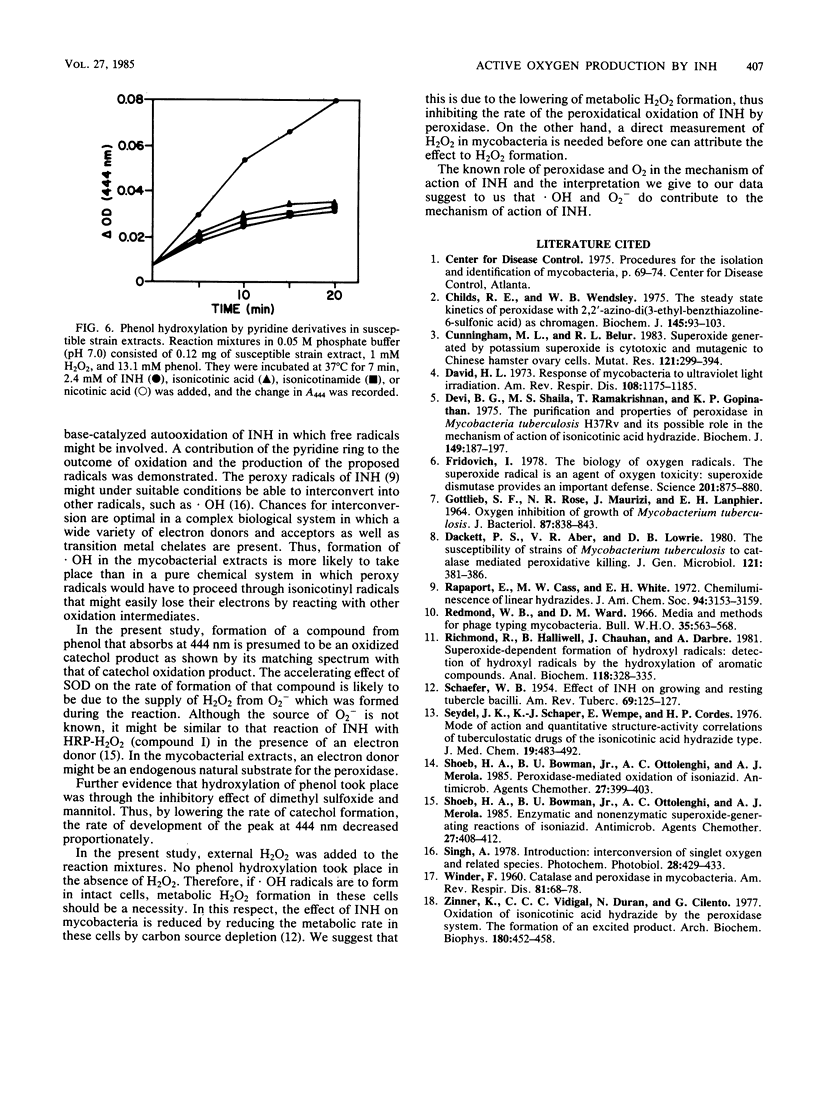Abstract
Crude extracts of Mycobacterium tuberculosis H37Ra, an isonicotinic acid hydrazide (isoniazid) (INH)-susceptible strain which has peroxidase activity, catalyzed the production of catechol from phenol in the presence of INH and H2O2 as shown by the development of the 444-nm absorption peak of oxidized catechol product. Extracts of the INH-resistant strain of M. tuberculosis H37Ra, which has no peroxidase, did not catalyze the reaction. The rate of development of the 444-nm peak increased proportionately with increased superoxide dismutase concentrations. The hydroxyl radical (. OH) scavengers dimethylsulfoxide and mannitol inhibited the reaction. Isonicotinamide, isonicotinic acid, and nicotinic acid could not replace INH.
Full text
PDF



Selected References
These references are in PubMed. This may not be the complete list of references from this article.
- Childs R. E., Bardsley W. G. The steady-state kinetics of peroxidase with 2,2'-azino-di-(3-ethyl-benzthiazoline-6-sulphonic acid) as chromogen. Biochem J. 1975 Jan;145(1):93–103. doi: 10.1042/bj1450093. [DOI] [PMC free article] [PubMed] [Google Scholar]
- Cunningham M. L., Lokesh B. R. Superoxide anion generated by potassium superoxide is cytotoxic and mutagenic to chinese hamster ovary cells. Mutat Res. 1983 Sep;121(3-4):299–304. doi: 10.1016/0165-7992(83)90218-x. [DOI] [PubMed] [Google Scholar]
- David H. L. Response of Mycobacteria to ultraviolet light radiation. Am Rev Respir Dis. 1973 Nov;108(5):1175–1185. doi: 10.1164/arrd.1973.108.5.1175. [DOI] [PubMed] [Google Scholar]
- Devi B. G., Shaila M. S., Ramakrishnan T., Gopinathan K. P. The purification and properties of peroxidase in Mycobacterium tuberculosis H37Rv and its possible role in the mechanism of action of isonicotinic acid hydrazide. Biochem J. 1975 Jul;149(1):187–197. doi: 10.1042/bj1490187. [DOI] [PMC free article] [PubMed] [Google Scholar]
- Fridovich I. The biology of oxygen radicals. Science. 1978 Sep 8;201(4359):875–880. doi: 10.1126/science.210504. [DOI] [PubMed] [Google Scholar]
- GOTTLIEB S. F., ROSE N. R., MAURIZI J., LANPHIER E. H. OXYGEN INHIBITION OF GROWTH OF MYCOBACTERIUM TUBERCULOSIS. J Bacteriol. 1964 Apr;87:838–843. doi: 10.1128/jb.87.4.838-843.1964. [DOI] [PMC free article] [PubMed] [Google Scholar]
- Jackett P. S., Aber V. R., Lowrie D. B. The susceptibility of strains of Mycobacterium tuberculosis to catalase-mediated peroxidative killing. J Gen Microbiol. 1980 Dec;121(2):381–386. doi: 10.1099/00221287-121-2-381. [DOI] [PubMed] [Google Scholar]
- Redmond W. B., Ward D. M. Media and methods for phage-typing mycobacteria. Bull World Health Organ. 1966;35(4):563–568. [PMC free article] [PubMed] [Google Scholar]
- Richmond R., Halliwell B., Chauhan J., Darbre A. Superoxide-dependent formation of hydroxyl radicals: detection of hydroxyl radicals by the hydroxylation of aromatic compounds. Anal Biochem. 1981 Dec;118(2):328–335. doi: 10.1016/0003-2697(81)90590-x. [DOI] [PubMed] [Google Scholar]
- SCHAEFER W. B. The effect of isoniazid on growing and resting tubercle bacilli. Am Rev Tuberc. 1954 Jan;69(1):125–127. doi: 10.1164/art.1954.69.1.125. [DOI] [PubMed] [Google Scholar]
- Seydel J. K., Schaper K. J., Wempe E., Cordes H. P. Mode of action and quantitative structure-activity correlations of tuberculostatic drugs of the isonicotinic acid hydrazide type. J Med Chem. 1976 Apr;19(4):483–492. doi: 10.1021/jm00226a007. [DOI] [PubMed] [Google Scholar]
- Shoeb H. A., Bowman B. U., Jr, Ottolenghi A. C., Merola A. J. Enzymatic and nonenzymatic superoxide-generating reactions of isoniazid. Antimicrob Agents Chemother. 1985 Mar;27(3):408–412. doi: 10.1128/aac.27.3.408. [DOI] [PMC free article] [PubMed] [Google Scholar]
- Shoeb H. A., Bowman B. U., Jr, Ottolenghi A. C., Merola A. J. Peroxidase-mediated oxidation of isoniazid. Antimicrob Agents Chemother. 1985 Mar;27(3):399–403. doi: 10.1128/aac.27.3.399. [DOI] [PMC free article] [PubMed] [Google Scholar]
- Singlet oxygen and related species in chemistry and biology. Proceedings of the international conference, held at Pinawa, Manitoba, Canada, on 21-26 August 1977. Photochem Photobiol. 1978 Oct-Nov;28(4-5):429–933. [PubMed] [Google Scholar]
- WINDER F. Catalase and peroxidase in mycobacteria. Possible relationship to the mode of action of isoniazid. Am Rev Respir Dis. 1960 Jan;81:68–78. doi: 10.1164/arrd.1960.81.1P1.68. [DOI] [PubMed] [Google Scholar]
- Zinner K., Vidigal C. C., Durán N., Cilento G. Oxidation of isonicotinic acid hydrazide by the peroxidase system. The formation of an excited product. Arch Biochem Biophys. 1977 Apr 30;180(2):452–458. doi: 10.1016/0003-9861(77)90059-5. [DOI] [PubMed] [Google Scholar]


